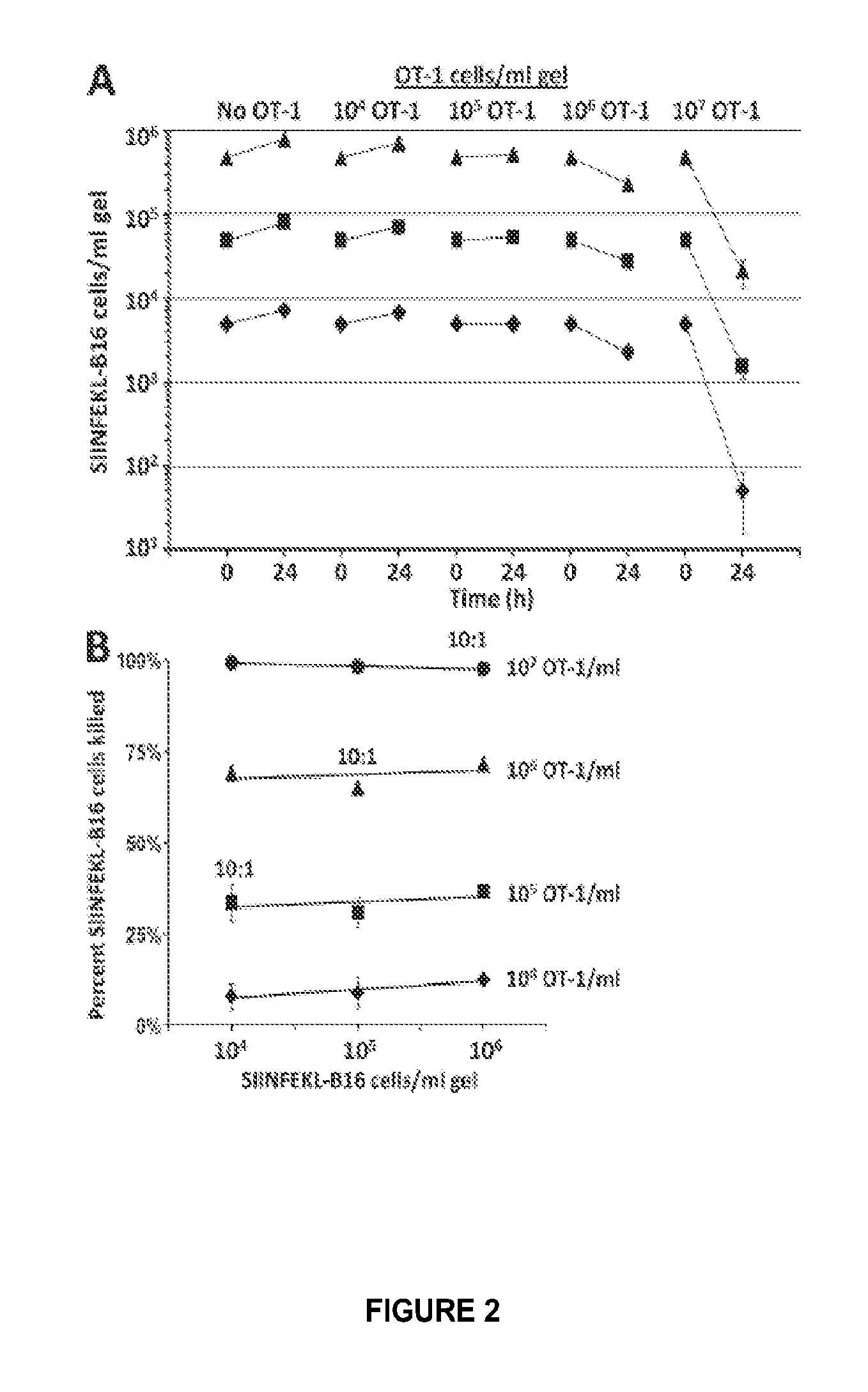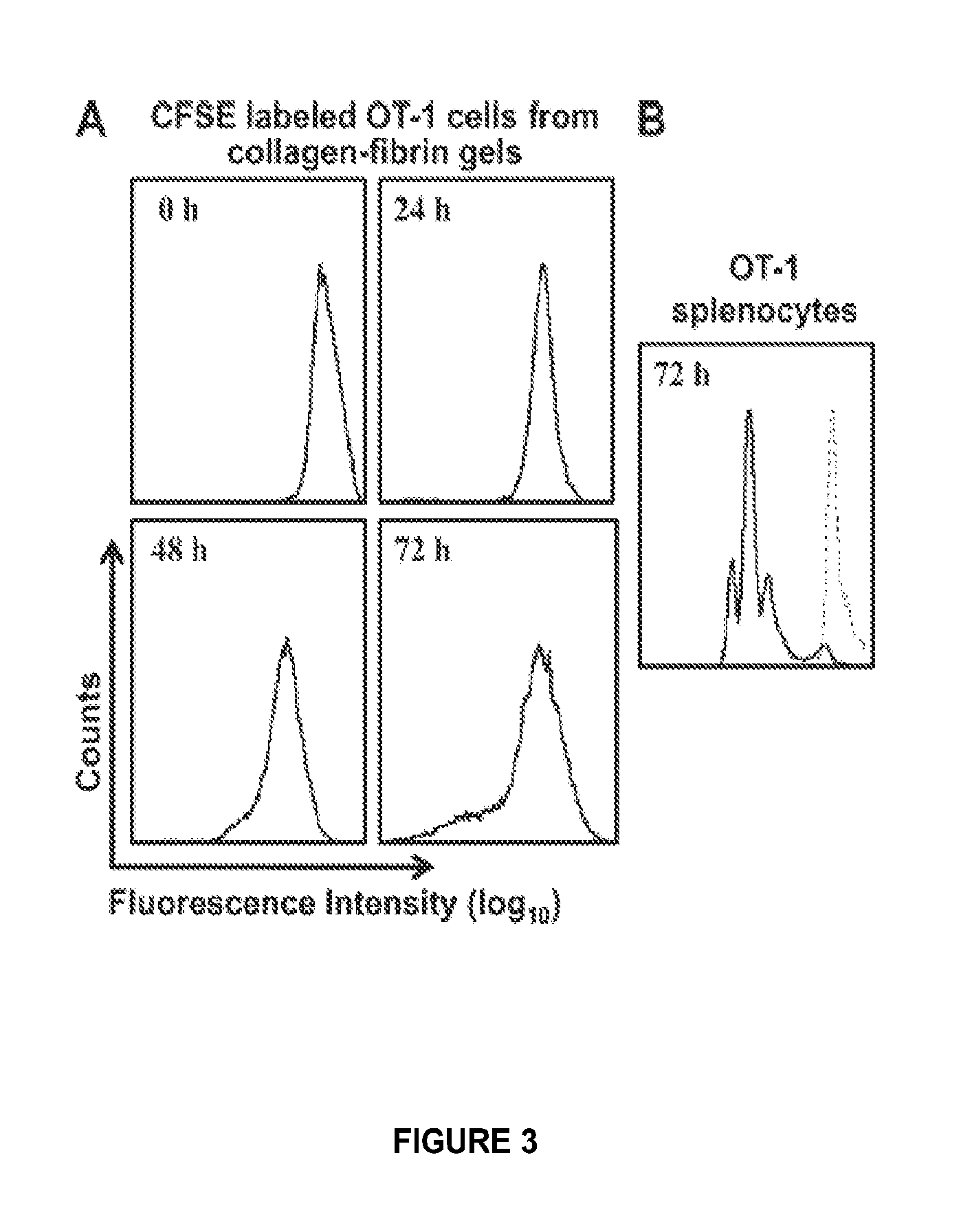Methods, compositions, and assays for determining the effect of an immune cell on a cell from an infectious or neoplastic disease
- Summary
- Abstract
- Description
- Claims
- Application Information
AI Technical Summary
Benefits of technology
Problems solved by technology
Method used
Image
Examples
example 1
[0380]Materials.
[0381]Human fibrinogen was obtained from American Diagnostica Inc., collagen I, cell culture inserts and tissue culture plates from BD, SIINFEKL peptide (OVA 257-264) from American Peptide Company, CFSE from Invitrogen, and recombinant mouse IL-2 from Millipore. All other reagents were purchased from Sigma-Aldrich. All experiments using mice were Institutional Review Board approved by Columbia University.
[0382]Cells.
[0383]B16 melanoma cells (vol.=2,757 μm3 assuming spherical diameter=17.4 μm [Ochalek, et al., 1988]; H2-Kb [Hu and Lesney, 1964]), were maintained as monolayer cultures in RPMI 1640 medium supplemented with 10% FBS and 50 μM β-ME (OT-1 growth medium) at 37° C. in a 95% air / 5% CO2 humidified atmosphere, detached by incubation at 37° C. for 5 min in PBS containing 5 mM EDTA, pelleted by centrifugation (400 g for 10 min), and resuspended at 106 cells / ml in OT-1 growth medium. Where indicated, B16 cells were incubated in suspension at 106 cells / ml in RPMI me...
example 2
[0402]Materials:
[0403]72-well Terasaki plates (NUNC brand) from VWR International (West Chester, Pa.); fetal bovine serum and RPMI 1640 medium were from Invitrogen Corp. (Carlsbad, Calif.); and recombinant mouse IL-21 from Chemicon (Temecula, Calif.). All other materials were obtained as described (Budhu et al., 2010).
[0404]Cells:
[0405]B16 melanoma cells (H2-Kb) (Hu and Lesney, 1964), were maintained, harvested and pulsed with SIINFEKL peptide, and OT-1 CD8+ T-cells were harvested, activated, purified, and used exactly as described (Budhu et al., 2010). For experiments described in FIGS. 5 and 6 only, one set of OT-1 cells was activated in Dulbecco's Minimal Essential Medium with 1 mM sodium pyruvate and non-essential amino acids. Limiting dilution assays showed 2.56% of OT-1 cells activated in this medium were cytolytically active.
[0406]Formation of Collagen-I-Fibrin Gels Containing B16 and OT-1 Cells.
[0407]Collagen / fibrin gels were formed, incubated, and lysed, and their contents ...
example 3
[0416]Only 0.86% of MHC-Ikb-SIINFEKL tetramer positive CD8+ OT-1 T-cells from unimmunized OT-1 mouse spleen kill SIINFEKL peptide-pulsed B16 cells. Immunization of OT-1 mice with anti-DEC205-IgG-ovalbumin increased the percentage of cytolytically active tetramer positive OT-1 spleen cells to 1.9%, but had no effect on their specific cytolytic activity (number of SIINFEKL-B16 cells killed / cytolytically active OT-1 cell / d). In contrast, immunization with anti-DEC205-IgG plus anti-CD40-IgG increased the percentage of cytolytically active OT-1 cells to 2.4%, and their specific cytolytic activity by 133%. We observed similar increases in the fraction, specific cytolytic activity, and killing efficiency (as measured by a previously described killing constant k), of SIINFEKL-B16 cells by OT-1 cells following their activation in vitro in medium containing SIINFEKL and IL-12 or IL-21 vs. in medium containing SIINFEKL and IL-2. The efficiency with which in vitro activated OT-1 cells kill SIIN...
PUM
| Property | Measurement | Unit |
|---|---|---|
| diameter | aaaaa | aaaaa |
| diameters | aaaaa | aaaaa |
| diameters | aaaaa | aaaaa |
Abstract
Description
Claims
Application Information
 Login to View More
Login to View More - R&D
- Intellectual Property
- Life Sciences
- Materials
- Tech Scout
- Unparalleled Data Quality
- Higher Quality Content
- 60% Fewer Hallucinations
Browse by: Latest US Patents, China's latest patents, Technical Efficacy Thesaurus, Application Domain, Technology Topic, Popular Technical Reports.
© 2025 PatSnap. All rights reserved.Legal|Privacy policy|Modern Slavery Act Transparency Statement|Sitemap|About US| Contact US: help@patsnap.com



